矮牛缺素症的表现
参考:https://www.ces.ncsu.edu/depts/hort/floriculture/def/petunia.htm
缺氮
Nitrogen-deficient petunias have mature leaves that turn greenish-yellow to a uniform light yellow. The young leaves are narrow and are darker green.
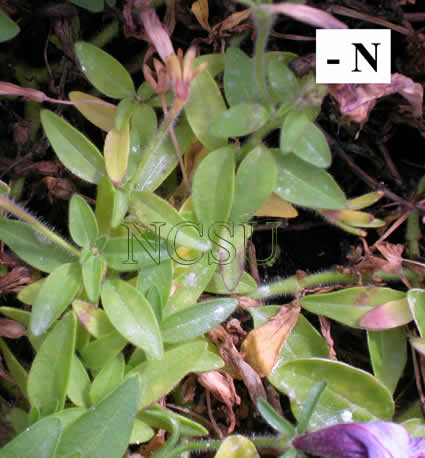
At the advanced stage, the lower leaves express a purplish pigmentation. Necrosis begins on the leaf tips and margins.
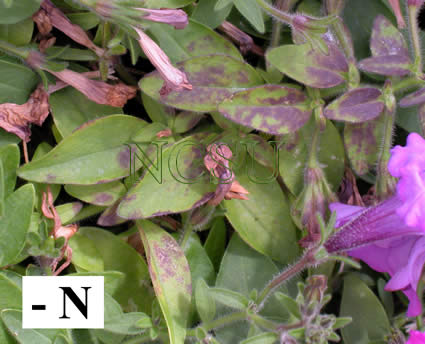
| |
|
|---|---|
| The amount of fertilizer supplied is lower than the crop's nutrient demand (crops are categorized as light, medium or heavy feeders), or at a particular stage of development (high N demanding crops can deplete substrate N levels, especially near bloom). | 1. Increase fertilization frequency (use more frequent fertilization irrigations instead of clear water irrigations). 2. Increase fertilizer rate. 3. Avoid leaching the substrate with clear water irrigations. 4. Recheck the EC values to make sure they are within the acceptable range. |
| Leaching too great. | 1. Avoid leaching the substrate with clear water irrigations. 2. Recheck the EC values to make sure they are within the acceptable range. |
| Injector malfunction. | 1. Check the EC of the clear water and the fertilizer solution. Fertilizer solution EC minus clear water EC = EC contribution of the fertilizer. Compare this value with the tables on the fertilizer bag to determine the fertilization rate being applied. |
| Fertilizer mixing rate error and too little fertilizer used. | 1. Check if the amount of fertilizer used, the size of the concentrate bucket, and the proportioner setting are correct. |
| Slow release of N from slow release fertilizer is due to low temperatures or use of wrong product (eg. 90 day release instead of 30 day release). | 1. Avoid clear water irrigations to avoid leaching the fertilizer. 2. Provide supplemental fertilizer with a water soluble fertilizer. |
缺磷
Leaves are smaller and develop dark-purple patches. The midvein becomes dark purple starting at the base and pigmentation moves toward the tip of the leaf.
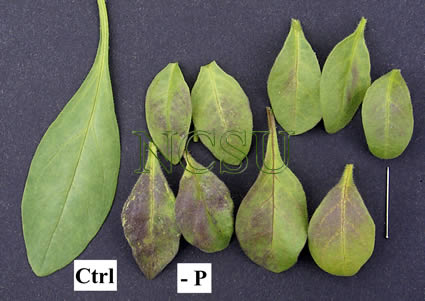
Phosphorus-deficient plants are smaller in size.
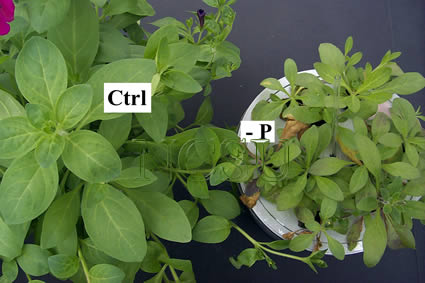
The deficiency progresses from dark-purple patches to a brown papery necrosis.
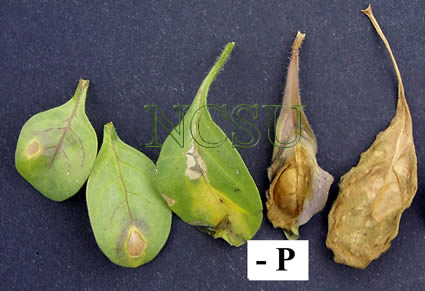
| |
|
|---|---|
| The amount of fertilizer supplied is lower than the crop's nutrient demand (crops are categorized as light, medium or heavy feeders), or at a particular stage of development (actively growing plants have greater nutrient demands than young or flowering plants). | 1. Increase fertilization frequency (use
more frequent fertilization irrigations instead of clear water irrigations). 2. Increase fertilizer rate. 3. Avoid leaching the substrate with clear water irrigations. 4. Recheck the EC values to make sure they are within the acceptable range. |
| P lacking in fertilizer program (eg. no P starter charge used or dark weather feed [calcium nitrate + potassium nitrate] used which does not contain P). | 1. Use a fertilizer that contains P. 2. If injecting acid to neutralize alkalinity, consider supplying P from phosphoric acid (upper limit of 10 to 15 ppm P). |
| Leaching too great. | 1. Avoid leaching the substrate with clear water irrigations. 2. Recheck the EC values to make sure they are within the acceptable range. |
| Injector malfunction. | 1. Check the EC of the clear water and the fertilizer solution. Fertilizer solution EC minus clear water EC = EC contribution of the fertilizer. Compare this value with the tables on the fertilizer bag to determine the fertilization rate being applied. |
| Fertilizer mixing rate error and too little fertilizer used. | 1. Check if the amount of fertilizer used, the size of the concentrate bucket, and the proportioner setting are correct. |
缺钾
A yellow-green interveinal chlorosis appears on recently mature leaves. As symptoms progress, the chlorotic regions develop tan, papery, necrotic spots that fuse into larger patches.
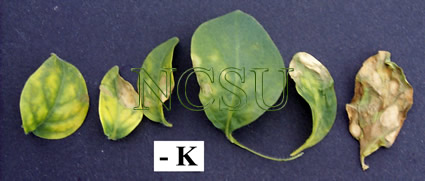
Mature leaves turn completely tan and wither at the advanced stage.
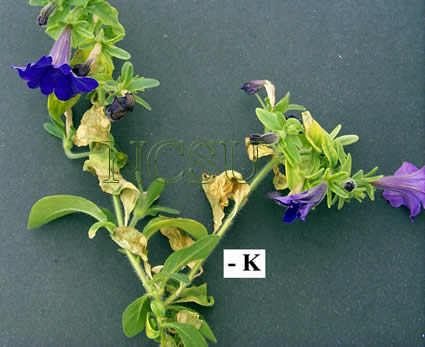
| |
|
|---|---|
| The amount of fertilizer supplied is lower than the crop's nutrient demand (crops are categorized as light, medium or heavy feeders), or at a particular stage of development (high K demanding crops can deplete substrate K levels, especially near bloom). | 1. Increase K fertilization frequency (use
more frequent fertilization irrigations instead of clear water irrigations). 2. Increase K fertilizer rate or apply a single dose of KNO3 at 200 to 300 ppm K. 3. Avoid leaching the substrate with clear water irrigations. 4. Recheck the EC values to make sure they are within the acceptable range. |
| Excessive leaching. | 1. Avoid leaching the substrate with clear water irrigations. 2. Recheck the EC values to make sure they are within the acceptable range. |
| Injector malfunction. | 1. Check the EC of the clear water and the fertilizer solution. Fertilizer solution EC minus clear water EC = EC contribution of the fertilizer. Compare this value with the tables on the fertilizer bag to determine the fertilization rate being applied. |
| Fertilizer mixing rate error and too little fertilizer used. | 1. Check if the amount of fertilizer used, the size of the concentrate bucket, and the proportioner setting are correct. |
缺钙
Calcium-deficient plants are stunted and have smaller leaves, as compared to the control.

As symptoms progress, brown to dark-purple spots develop on the mid-regions of the young and recently mature leaves of the axillary shoots. The youngest leaves become deformed and are straplike in appearance, while the margins turn chlorotic.
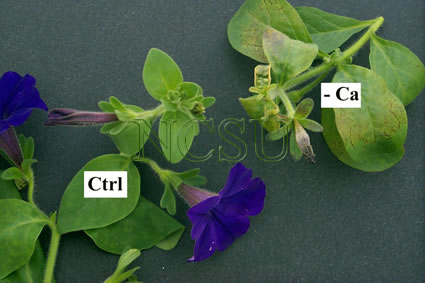
As the deficiency advances, purplish spotting quickly develops into necrotic areas on the youngest leaves. The recently mature leaves have large, purplish patches that appear on the margins moving in toward the midvein. Flowers wither prematurely.
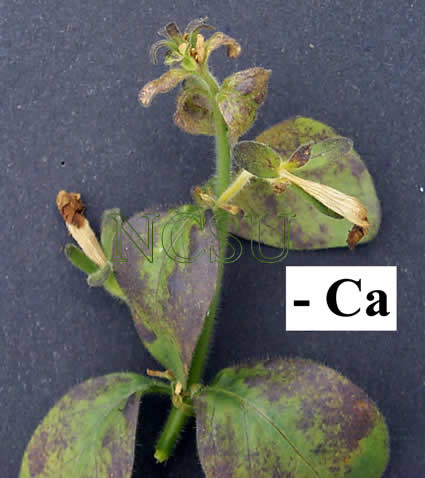
| |
|
|---|---|
| The amount of fertilizer supplied is lower than the crop's nutrient demand (crops are categorized as light, medium or heavy feeders), or at a particular stage of development (high Ca demanding crops can deplete substrate Ca levels, especially near bloom). | 1. Increase fertilization frequency (use
more frequent fertilization irrigations instead of clear water irrigations). 2. Increase fertilizer rate. 3. Avoid leaching the substrate with clear water irrigations. 4. Recheck the EC values to make sure they are within the acceptable range. |
| Not using a fertilizer containing calcium (eg. 20-10-20 or 20-20-20). | 1. Use a fertilizer that contains Ca. 2. Increase the preplant level of Ca. |
| Little or no calcium provided through the irrigation water. | 1. Use a fertilizer that contains Ca. 2. Increase the preplant level of Ca. |
| Insufficient lime charge added to supply adequate calcium levels. | 1. Use a fertilizer that contains Ca. 2. Provide adequate Ca when mixing the substrate. |
| Excessive leaching. | 1. Avoid leaching the substrate with clear water irrigations. 2. Recheck the EC values to make sure they are within the acceptable range. |
| Injector malfunction. | 1. Check the EC of the clear water and the fertilizer solution. Fertilizer solution EC minus clear water EC = EC contribution of the fertilizer. Compare this value with the tables on the fertilizer bag to determine the fertilization rate being applied. |
| Fertilizer mixing rate error and too little fertilizer used. | 1. Check if the amount of fertilizer used, the size of the concentrate bucket, and the proportioner setting are correct. |
缺锰
Magnesium-deficient plants have young and recently mature leaves that express a greenish-yellow cast. A faint interveinal chlorosis is observed on the recently mature and older leaves. Mature leaves develop a thin band of marginal chlorosis that ultimately progresses to a tannish-gray necrosis.
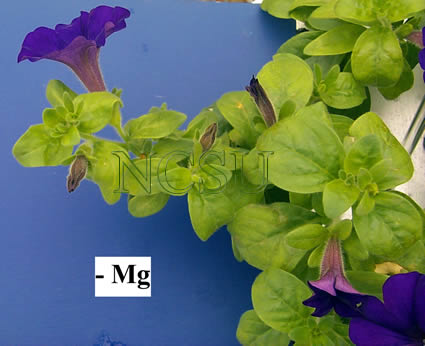
| |
|
|---|---|
| The amount of fertilizer supplied is lower than the crop's nutrient demand (crops are categorized as light, medium or heavy feeders), or at a particular stage of development (high Mg demanding crops can deplete substrate Mg levels, especially near bloom). | 1. Increase fertilization frequency (use
more frequent fertilization irrigations instead of clear water irrigations). 2. Increase fertilizer rate. 3. Avoid leaching the substrate with clear water irrigations. 4. Recheck the EC values to make sure they are within the acceptable range. |
| Not supplying preplant Mg as dolomitic limestone. | 1. Use dolomitic limestone for initial adjustment of substrate pH. |
| Not using a fertilizer containing magnesium (eg. 20-10-20 or 20-20-20). | 1. Use a fertilizer which contains Mg. |
| Monthly applications of magnesium sulfate not made. | 1. Apply monthly epsom salts (magnesium sulfate) drenches at the rate of 1 to 2 lbs per 100 gallons of water. |
| Little or no magnesium provided through the irrigation water. | 1. Use a fertilizer which contains Mg. 2. Apply monthly epsom salts (magnesium sulfate) drenches at the rate of 1 to 2 lbs per 100 gallons of water. |
| Excessive leaching. | 1. Avoid leaching the substrate with clear water irrigations. 2. Recheck the EC values to make sure they are within the acceptable range. |
| Injector malfunction. | 1. Check the EC of the clear water and the fertilizer solution. Fertilizer solution EC minus clear water EC = EC contribution of the fertilizer. Compare this value with the tables on the fertilizer bag to determine the fertilization rate being applied. |
| Fertilizer mixing rate error and too little fertilizer used. | 1. Check if the amount of fertilizer used, the size of the concentrate bucket, and the proportioner setting are correct. |
缺硫
The mature leaves of sulfur-deficient plants are light green while the young leaves are greenish-yellow.
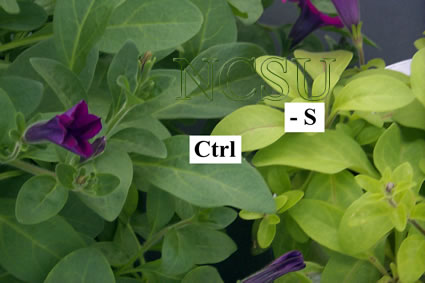
The overall size of the plant is severely stunted with very little axillary growth. Flowering is reduced compared to the control.

Recently mature leaves turn greenish-yellow to light yellow as symptoms progress. Eventually, the yellow leaves wither and turn brown. The midvein turns brown, with necrosis progressing from the base of the leaf moving toward the leaf tip.
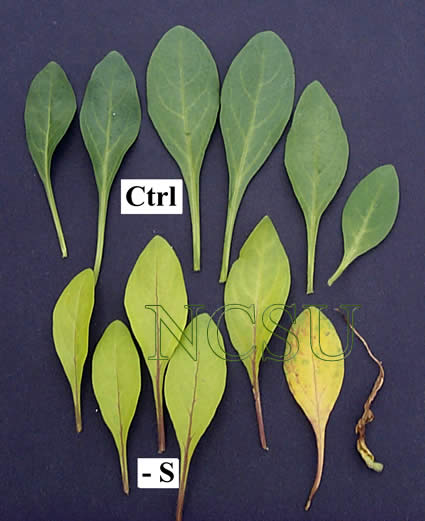
| |
|
|---|---|
| Not using a fertilizer containing sulfur (eg. 20-10-20 or 20-20-20). | 1. Use a fertilizer which contains S. |
| Monthly applications of magnesium sulfate not made. | 1. Apply monthly epsom salts (magnesium sulfate) drenches at the rate of 1 to 2 lbs per 100 gallons of water. |
| Little or no sulfur provided through the irrigation water. | 1. Use a fertilizer which contains S. |
微量元素硼
Boron-deficient plants are severely stunted, compact and dull green when compared to the control.

The growing point has a deformed rosettelike appearance and bud abortion is apparent. The young leaves are thick and a glossy dark green color exists.

Some of the recently mature and mature leaves have a yellow-green chlorosis on the leaf tips that starts at the margin and move inward towards the midvein.
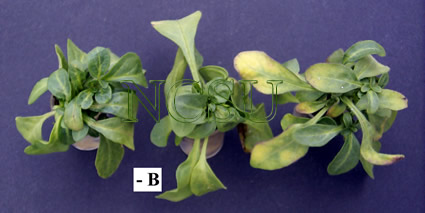
As symptoms progress the midvein turns dark brown to black, starting at the base of the leaf moving toward the leaf tip. Brown necrotic spots fuse to create random brown patches on recently mature leaf margins.
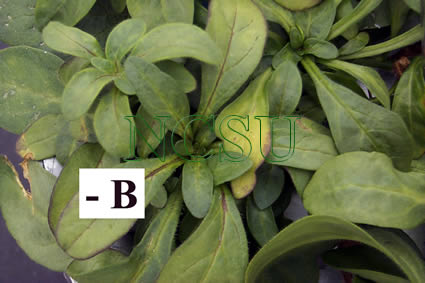
| |
|
|---|---|
| Not using a fertilizer containing boron (eg. calcium nitrate + potassium nitrate). | 1. Use a fertilizer which contains B. Foliar sprays have a greater risk of plant injury. Avoid applications during the midday heat. Plant uptake is enhanced by prolonged drying time, which occurs during humid conditions, especially in the morning. Nutrient uptake through the leaves is also greater in the day than at night, making morning applications more desirable than evening sprays. |
| Little or no boron provided through the irrigation water. | 1. Use a fertilizer that contains B. |
微量元素铜
Copper-deficient leaves are smaller and narrower than the control leaves. Deficient leaves have deformed margins and express a light green interveinal chlorosis.
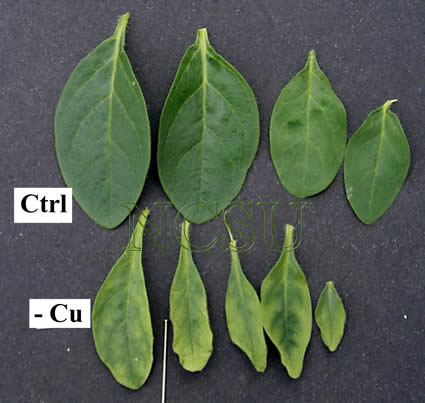
Flower size is significantly smaller than the control.

| |
|
|---|---|
| Not using a fertilizer containing copper (eg. calcium nitrate + potassium nitrate). | 1. Use a fertilizer that contains Cu. Foliar sprays have a greater risk of plant injury. Avoid applications during the midday heat. Plant uptake is enhanced by prolonged drying time, which occurs during humid conditions, especially in the morning. Nutrient uptake through the leaves is also greater in the day than at night, making morning applications more desirable than evening sprays. |
| Little or no copper provided through the irrigation water. | 1. Use a fertilizer which contains Cu. |
微量元素铁
Initial symptoms develop as a distinct yellow-green interveinal chlorosis on the younger leaves. Symptoms progress from the leaf base to the tip.
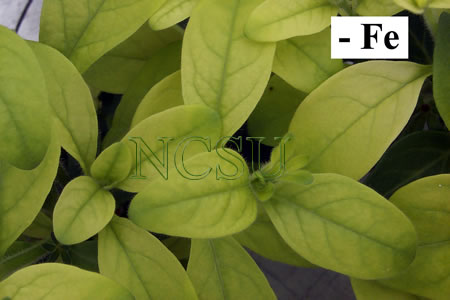
Severe iron deficiency results in the young leaves turning light yellow to white, while the oldest mature leaves remain green.
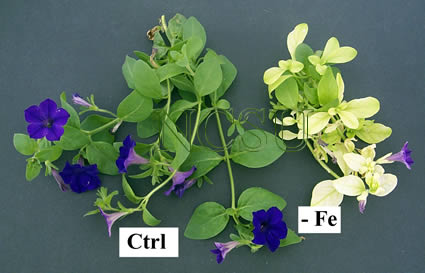
| |
|
|---|---|
| Not using a fertilizer containing Fe (eg. calcium nitrate + potassium nitrate). | 1. Use a fertilizer that contains Fe. Foliar sprays have a greater risk of plant injury. Avoid applications during the midday heat. Plant uptake is enhanced by prolonged drying time, which occurs during humid conditions, especially in the morning. Nutrient uptake through the leaves is also greater in the day than at night, making morning applications more desirable than evening sprays. |
| Substrate pH is too high, inducing iron deficiency. | 1. Test the substrate pH to determine if it is too high (> pH 6.5). 2. Neutralize the alkalinity of the irrigation water with acid injection. 3. Switch from a basic fertilizer to an acidic fertilizer. 4. Apply iron sulfate (FeSO4.7H2O) as a substrate drench. Use 1 to 3 pounds per 100 gallons of water. Wash off the foliage after application. 5. Recheck the pH values to make sure they are within the acceptable range. |
| Little or no Fe provided through the irrigation water. | 1. Use a fertilizer that contains Fe. |
微量元素锰
Young leaves of manganese-deficient plants are uniform greenish-yellow. The recently mature leaves develop a random light yellow interveinal chlorosis.
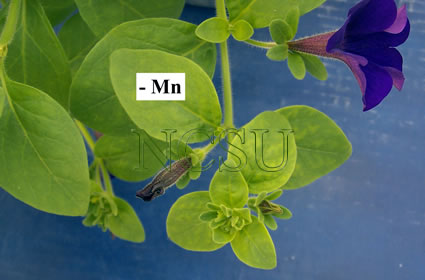
| |
|
|---|---|
| Not using a fertilizer containing Mn (eg. calcium nitrate + potassium nitrate). | 1. Use a fertilizer that contains Mn. Foliar sprays have a greater risk of plant injury. Avoid applications during the midday heat. Plant uptake is enhanced by prolonged drying time, which occurs during humid conditions, especially in the morning. Nutrient uptake through the leaves is also greater in the day than at night, making morning applications more desirable than evening sprays. |
| Little or no Mn provided through the irrigation water. | 1. Use a fertilizer that contains Mn. |
微量元素锌
A light-green chlorosis develops at the basal region of the young leaves. The young and recently mature leaves begin to buckle and twist, making them appear deformed.
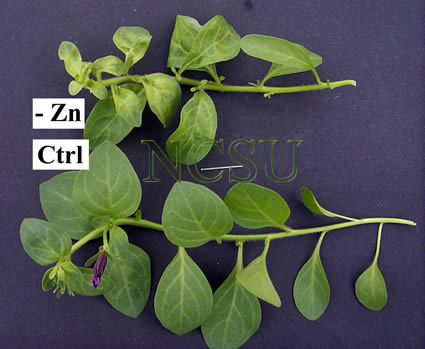
Young leaf chlorosis turns to tan, papery, necrosis.
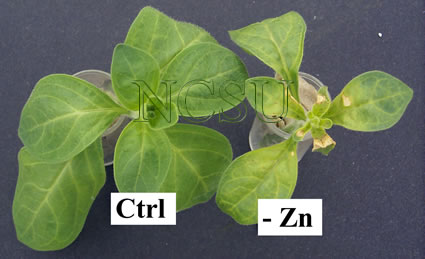
Close-up of necrotic patches.
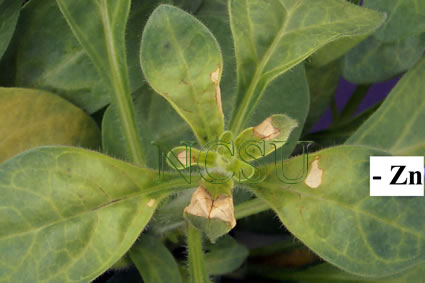
Zinc-deficient leaves are smaller and duller green than the control. At the advanced stage, tissue is tannish-white and brittle.
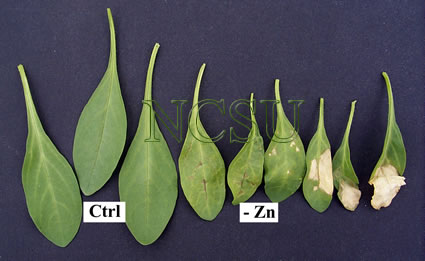
| |
|
|---|---|
| Not using a fertilizer containing Zn (eg. calcium nitrate + potassium nitrate). | 1. Use a fertilizer which contains Zn. Foliar sprays have a greater risk of plant injury. Avoid applications during the midday heat. Plant uptake is enhanced by prolonged drying time, which occurs during humid conditions, especially in the morning. Nutrient uptake through the leaves is also greater in the day than at night, making morning applications more desirable than evening sprays. |
| Little or no Zn provided through the irrigation water. | 1. Use a fertilizer that contains Zn. |